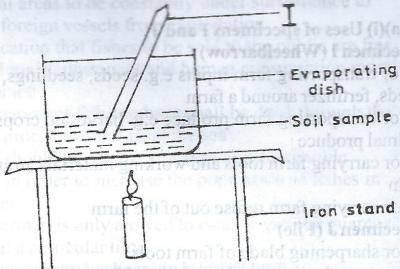Year :
2018
Title :
Agricultural Science
Exam :
WASSCE/WAEC MAY/JUNE
Paper 1 | Objectives
11 - 20 of 50 Questions
| # | Question | Ans |
|---|---|---|
| 11. |
Which of the following is an example of igneous rock? A. Basalt B. Dolomite C. Limestone D. Marble |
A |
| 12. |
The chemical composition of soil is mostly influenced by A. Climate B. Time C. Topography D. Parent material |
D |
| 13. |
The structure of loam could be described as A. single-grained B. blocky C. crumby D. platy |
C |
| 14. |
 The aim of the experiment illustrated above is to A. determine soil texture B. ascertain water content of the soil C. examine the structure of the soil D. determine soil acidity |
B |
| 15. |
 The purpose of the part labelled I in the experiment illustrated above is to A. allow proper aggregation of soil particles B. allow even evaporation of water C. prevent water from escaping D. distribute water around the soil |
B |
| 16. |
A beneficial effect of bush burning on the soil is the A. reduction of soil microbial activities B. exposure of soil surface to erosion C. destruction of weed seeds D. improves soil water holding capacity |
C |
| 17. |
Which of the following practices does not replenish lost soil nutrients? A. crop rotation B. fallowing C. Liming D. Bush burning |
D |
| 18. |
The use of inorganic fertilizer is preferable to organic manure because inorganic fertilizer A. improves soil structure B. releases nutrients to the soil faster C. reduces leaching of soil nutrients D. improves soil water holding capacity |
B |
| 19. |
Which of the following statement describes an advantage of underground drainage? It A. allows for free movement of farm machinery B. checks the growth of weeds C. improves soil texture D. increases organic matter content of soil |
A |
| 20. |
Which of the following crops is usually classified as a vegetable? A. Lycopersicon esculentum B. Ananas sativa C. Hevea brasiliensis D. Theobroma cacao |
A |
| 11. |
Which of the following is an example of igneous rock? A. Basalt B. Dolomite C. Limestone D. Marble |
A |
| 12. |
The chemical composition of soil is mostly influenced by A. Climate B. Time C. Topography D. Parent material |
D |
| 13. |
The structure of loam could be described as A. single-grained B. blocky C. crumby D. platy |
C |
| 14. |
 The aim of the experiment illustrated above is to A. determine soil texture B. ascertain water content of the soil C. examine the structure of the soil D. determine soil acidity |
B |
| 15. |
 The purpose of the part labelled I in the experiment illustrated above is to A. allow proper aggregation of soil particles B. allow even evaporation of water C. prevent water from escaping D. distribute water around the soil |
B |
| 16. |
A beneficial effect of bush burning on the soil is the A. reduction of soil microbial activities B. exposure of soil surface to erosion C. destruction of weed seeds D. improves soil water holding capacity |
C |
| 17. |
Which of the following practices does not replenish lost soil nutrients? A. crop rotation B. fallowing C. Liming D. Bush burning |
D |
| 18. |
The use of inorganic fertilizer is preferable to organic manure because inorganic fertilizer A. improves soil structure B. releases nutrients to the soil faster C. reduces leaching of soil nutrients D. improves soil water holding capacity |
B |
| 19. |
Which of the following statement describes an advantage of underground drainage? It A. allows for free movement of farm machinery B. checks the growth of weeds C. improves soil texture D. increases organic matter content of soil |
A |
| 20. |
Which of the following crops is usually classified as a vegetable? A. Lycopersicon esculentum B. Ananas sativa C. Hevea brasiliensis D. Theobroma cacao |
A |